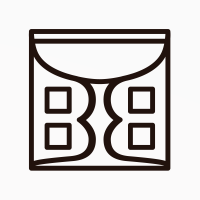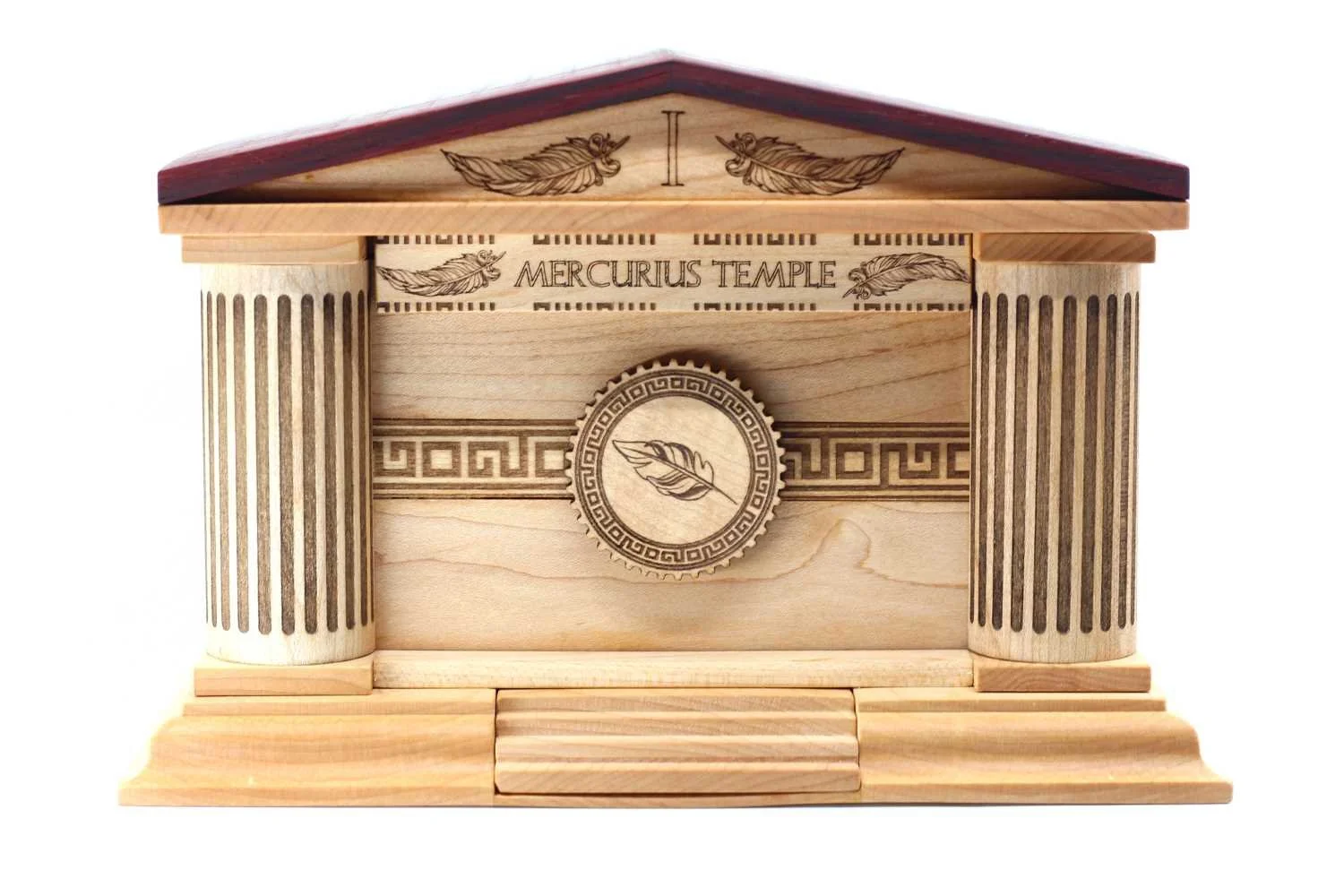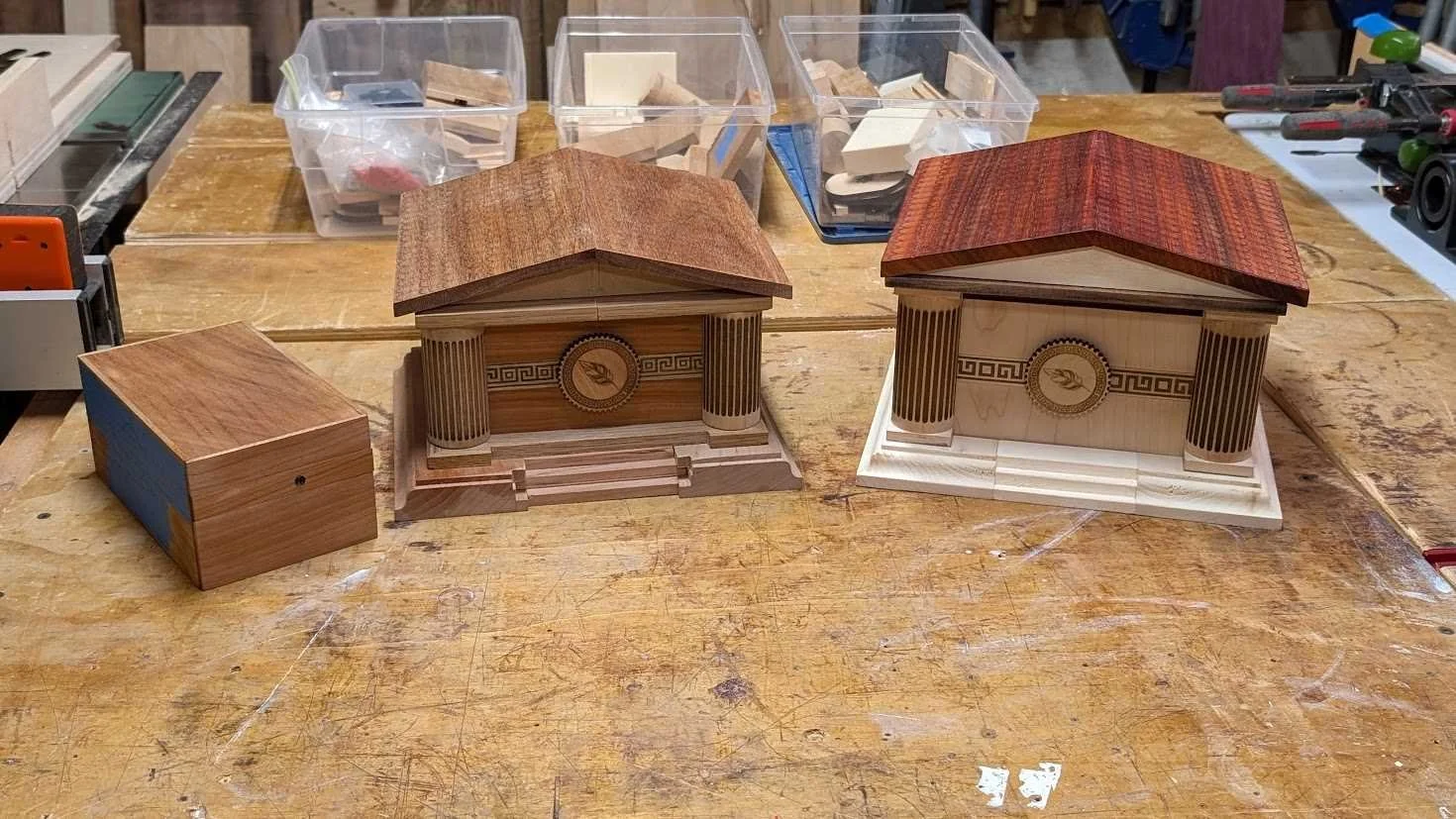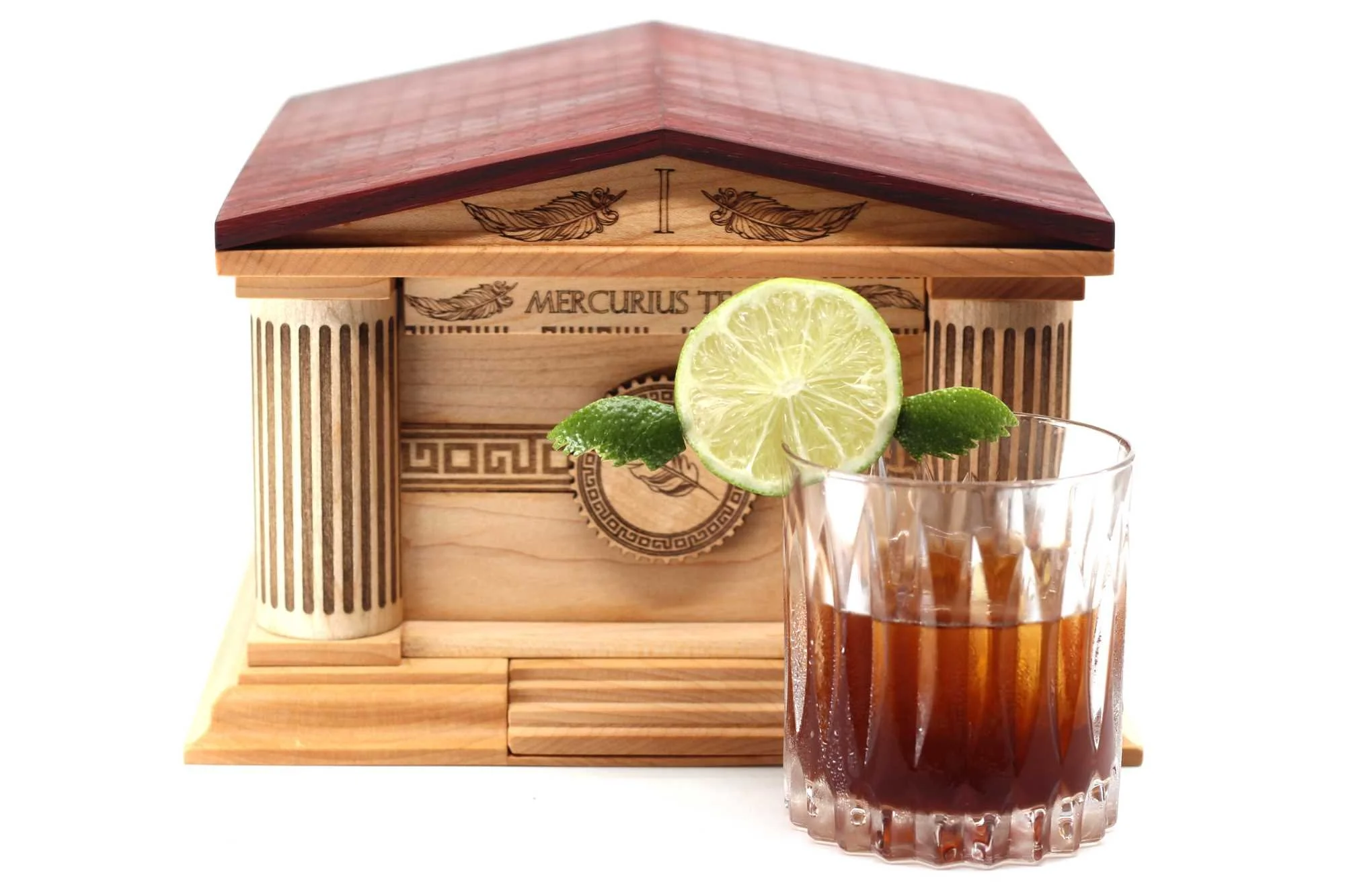Taking Flight
The Mercurius Temple
The Mercurius Temple by Denis Heynen
As the planets enact their unending cycles around the sun, the smallest among them is also swiftest, speeding through a complete rotation in just 88 “Earth” days. So named because of this speed, Mercury the planet references the Roman name of Hermes, the wing-sandaled Greek god, son of Zeus and the nymph Maia. Mercury was the messenger between the gods and humans, the cleverest of them all, who ruled over commerce, wealth, fertility, good fortune and trickery. What excellent inspiration for a grand and puzzling adventure!
a wing and a prayer
Denis Heynen has emerged from a distinguished career in the Royal Canadian Air Force into his second act, which, based on his debut creation, will surely be impressive. He shared the story of his journey and his debut puzzle box. “I’ve served for over 24 years in the Royal Canadian Air Force (RCAF) within the Communications and Electronics (C&E) branch, often called the ‘Signals’ branch. I began as an Aerospace Telecommunications and Information Systems technician (a long fancy title meaning I fixed and maintained radars, radios, computers, and networks) and now serve as a Communications and Electronics Engineering officer, after earning a degree in astrophysics (because why not?!).
courtesy of Denis Heynen
In the comms trades, the Roman god Mercury, known as Hermes in Greek mythology—or simply as ‘Jimmy’ to Branch members—stands as the patron and insignia of Signals branches across Commonwealth countries, and has always held a special place in my career (quite literally my trade badge on my chest and the cap badge on my headdress). As I retire next year and transition fully to puzzle designing and crafting, I chose the name Mercury Woodworks and embraced the title The Mercury Woodworker to honor my years of service. My first series of sequential discovery puzzle boxes, starting with the Mercurius Temple, draws deeply from this mythology, merging intricate, myth-inspired concepts with modern twists. I suspect there will often be some sort of reference to Mercury in most, if not all, of my puzzles, even if obscure."
courtesy of Denis Heynen
Denis was bitten by the puzzling bug about thirty years ago with the release of MYST, the influential video game many of us know and love. He still loves adventure games, but only started designing and crafting his own physical puzzles a few years ago, after discovering online solve videos which led him to Brian Menold’s book Wooden Puzzles. Soon after, he stumbled upon Jesse Born, who has documented his own evolution as a designer and maker in videos that inspired Denis. Both of them think that ideal puzzles take you on an adventure and tell a story.
courtesy of Denis Heynen
courtesy of Denis Heynen
The original idea wasn’t ‘Oooh, I need to make a greco-roman themed puzzle based on Mercury mythology!’ My process was ‘organic’... and let’s face it, that’s just a fancy way of saying “I don’t know what I’m doing but let’s see where this goes!”. I started with plans I had previously bought from Woodsmith magazine for ‘Clever Puzzle Boxes’, with no intent of crafting a product to sell. The thought process went something like this:
courtesy of Denis Heynen
- This box is too small, let’s make it square shaped...
- That’s a cool … mechanism to unlock the front panel - what if I made it so there were …?
- Ok, my skills aren’t good enough to conceal the … mechanisms, so let’s lean into it and make them really obvious and decorative.
- Hmm, I can’t quite get that little … inside to not fall apart, what if I added support to the corners ...
- Those square supports look odd, what if I made them round... hey they look like pillars!
- Laser engraver enters the chat. Let’s play with that!
- This is starting to look like a temple, what if we added a foundation and give it an ogee profile, that’s greco-roman, right?
- That flat roof looks wrong and the whole thing looks too bottom heavy... what are the proportions of a greco-roman temple roof line?
- (...)
- Bam. Mercurius Temple.
- And now to tell a story... because deep down I always wanted to be an author.
As the design evolved, it started taking shape and looked like a Greek temple to me. It just made sense to lean into my branding and name my first design in honour of my “patron deity”. Other discarded options included The Winged Vault, Hermes’ Challenge, Messenger’s Puzzle, Mercury’s Box...”
courtesy of Denis Heynen
Denis let the design evolve organically and leaned into the mechanisms and appearance rather than trying to stick to a single idea. The process was an incredible learning experience that he saw his way through, which is a testament to his abilities and grit. Finishing the first run of Temples was definitely not smooth sailing. “All. The. Challenges. Shitty tools. Lack of skill. Lack of time. Lack of space. Lack of knowledge. A vertical hill to ascend. The precision required in framing houses vs crafting an intricate puzzle are not quite on the same level. I wasn’t used to working with such fine tolerances. How do you “solve” lack of skill? Practice, make more things. It’s probably the main thing I still need to focus on as far as anything goes. I originally used a cigar box lock to latch the front panel. A cheap one. A good jostle and it would unlatch. So after perhaps a week or so of researching options, other lock types, and letting the ideas simmer, I came up with the [current] system I could fabricate myself. It’s nowhere near perfect, but I love the fact that this is how I came up with [that] aspect of the solution.”
courtesy of Denis Heynen
courtesy of Denis Heynen
The Mercurius Temple is “Primarily handcrafted using power tools in my garage workshop using Canadian hardwood maple, padauk, and some aspen. I do all the engraving and gear cutting on an xTool 10W diode laser, and all the components are manually sanded, finished, assembled, sanded, tested, sanded, and refinished.”
steps in the process - courtesy of Denis Heynen
Like any proper ancient temple, this one saw its share of ruins. Denis even planned a 'Mercurius Temple in Ruins edition'. The current 4 steps leading up to the Temple came about as an accident, initially destined for the ruins pile, due to an over cut and correction. But the look was much better, and once again Denis wisely did not try to deny fate.
Temple ruins - courtesy of Denis Heynen
Denis wanted the finale to reflect the puzzle theme, and originally envisioned hiding a metal or brass “puzzle” caduceus of Mercury inside. However, his skills in metalwork were not up to the challenge (“yet”, he says). Next he recalled the gaming adventure cliffhangers of the 80’s and 90’s he grew up with, and considered the idea of leaving a trail to the next puzzle in the series. Seasoned craftsmen including Robert Yarger and Brian Young cautioned him against this potentially frustrating “reward”, and he ultimately settled on a modified story line and a newly invented “artifact”.
a Greek tragedy - courtesy of Denis Heynen
Other changes along the way included a brief foray into recreating the original brightly colored painted pediments from ancient Greece, but backlash from the natural wood loving community was strong and the plain laser engraved detail look stuck.
earn your wings
I’ve often heard from designers that knowing when a puzzle design is finished can be a big challenge. “One of the first positions I held as an Officer in Canada’s equivalent of the ‘Space Force’ was on a SATCOM project, where we have a warning about watching for ‘Scope Creep’. My goal obviously wasn’t to design the greatest puzzle, just my ‘first’ puzzle, so I really had to limit the mechanics I included. I forced myself to adhere to a timeline for the prototyping. Countless times I thought “Oh, that would be cool if it did this or that...” and settled for making a note in my design journal instead of trying to add it for the sake of having ‘more moves’.
courtesy of Denis Heynen
And honestly a few ideas were just too ambitious for my current skill level as a craftsman, or even having the right tools - I suspect a CNC or a 3D printer would really open up the possibilities. I took notes of many elements and filed them away for future designs. [However,] In my early attempts to get pre-orders for the puzzle, I introduced a ‘stretch goal’ where I would add an additional hidden compartment if I could get a certain amount of pre-orders or IG followers before a set deadline. I succeeded, so ... I also have a background in electronics and programming. I suspect some of my future designs will incorporate these aspects in one form or another, to the chagrin of many old-school puzzlers I suspect.”
courtesy of Denis Heynen
courtesy of Denis Heynen
“The entire process was essentially a learning experience. The design, the woodworking, the prototyping, the line assembly process, the marketing, international exporting regulations, the existence of the Mechanical Puzzle Discord server!!! Quite literally everything about this last year. I’m nowhere near done learning, and very excited about this journey. But if I had to pick one thing that was the most significant - it’s the need to have my designs tested prior to going into full production mode. I discovered issues mid-production that could have been flagged much earlier.”
courtesy of Denis Heynen
The Mercurius Temple is an impressive creation that is clearly not the work of a novice, despite what Denis may claim. The woodworking is high end and the finishes and details are excellent. There is much to explore and discover. The adventure proceeds quickly and logically, with clever surprises in store and helpful hints along the way. You may not need to pray to the gods for advice, but watch out, as Mercury may well trick you with his wiles. It’s a fantastic debut for what promises to be an Olympic series.
stretch your wings
“The Mercurius Temple is the first in the Trials of Mercury trilogy. The next puzzle, Maximilian’s Monopteros, is already in the sketching phase and will feature a more involved gear mechanic system. It’ll be very different in both look and feel, but retain the theme and carry on the story I’m trying to weave. I also have several dozen ideas for other designs. I’m set for the next 40 years, and have a surplus of ideas to pass on to my kids if they decide to take over the puzzle crafting business. I’m incredibly grateful for the support I’ve already received from the puzzling community. I’m a completely unknown maker, having no previous experience, and being welcomed into this group of passionate puzzle solvers and collectors, designers and crafters, has been a little overwhelming in a very positive way. Thank you.”
The Messenger by Ryan Connelly
Here’s a toast to a mythological marvel in honor of Mercury, the god of messengers. It was created by Boston wine and spirits distributor Ryan Connelly while he was a bartender at Belly Wine Bar in 2013. Ryan created a menu full of fortified wine and vermouth based cocktails, of which this is a prime example. Vermouth is already a cocktail in a bottle, infused with herbs and botanicals from the region and fortified with neutral spirit. In Spain, vermouth with olives and an orange slice is a cultural experience all unto itself.
getting the message
In the Messenger, Bonal takes center stage as the base spirit, rather than whiskey, gin or any other high proof distillate. Bonal is a classic French aperitif Mistelle based wine, infused with gentian root, herbs from the Chartreuse mountains, and cinchona bark (quinine), which give it a lovely bittersweet flavor that is delicious all on its own. Here it works as a base that is augmented by more sweet vermouth and Calvados, the French apple and pear whiskey. Dry Curacao adds a touch of orange and a few bitters round out the experience, for a wonderfully complex, low proof cocktail that … delivers. Cheers!
don’t shoot the messengers
The Messenger by Ryan Connelly
1 ½ oz Bonal Gentiane-Quina
½ oz Cocchi Vermouth di Torino
½ oz Calvados
½ oz Pierre Ferrand Dry Curacao
1 dash mole bitters
1 dash orange bitters
Stir ingredients with ice and strain into a favorite glass. Orange twist.
explore more:






















